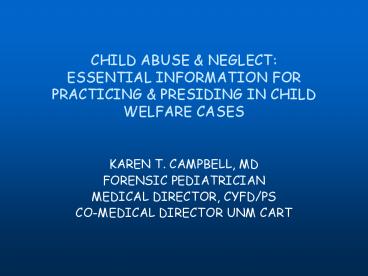child abuse & neglect: essential information for practicing - PowerPoint PPT Presentation
1 / 53
Title:
child abuse & neglect: essential information for practicing
Description:
child abuse & neglect: essential information for practicing & presiding in child welfare cases karen t. campbell, md forensic pediatrician medical director, cyfd/ps – PowerPoint PPT presentation
Number of Views:169
Avg rating:3.0/5.0
Title: child abuse & neglect: essential information for practicing
1
CHILD ABUSE NEGLECTESSENTIAL INFORMATION FOR
PRACTICING PRESIDING IN CHILD WELFARE CASES
- KAREN T. CAMPBELL, MD
- FORENSIC PEDIATRICIAN
- MEDICAL DIRECTOR, CYFD/PS
- CO-MEDICAL DIRECTOR UNM CART
2
Incidence and Prevalence
- There were approximately a million victims of
Child Maltreatment in 2005 in the United States. - The rate of victimization in the United States is
12.1 children per 1000 children.
3
Further breakdown of statistics
- In the United States-
- 54 of the children suffered from neglect
- 23 were physically abused
- 12 were sexually abused.
- Highest victimization rates were in the 0-3 year
age group.
4
In New Mexico
- The child population in New Mexico was 489,482
in 2005 - 32,950 children were the subject of a report for
abuse/neglect in 2005 - During the same year the rate of substantiation
was 14.9 per 1000 children - 12 children died as a result of abuse/neglect
during 2005
5
Remember, every day in America, four (4) children
die as a result of abuse and neglect!
6
- INJURIES IN CHILD ABUSE
7
Examples of External Injuries
- Contusions
- Abrasions
- Lacerations
- Incisions
- Thermal/Chemical/Scald Burns
8
Examples of Internal Injuries
- Fractures
- Contusion
- Laceration
- Incision
- Ischemia
- Edema
- Hemorrhage
9
Common sites of Accidental Injuries
- Forehead
- Forearms
- Elbows
- Spinal Prominences
- Hips / Iliac Crest
- Knees
- Shins
10
Common sites of Non-Accidental Injuries
- Face
- Ears
- Neck
- Upper Arms
- Back
- Chest and Abdomen
- Upper legs
- Buttocks
- Genitalia
11
Differentiating between Accidental and
Non-Accidental Trauma
- Age and/or developmental capability of the child
- Parent/Caretaker explanation for how the injury
occurred - Type of Injury
- Location of Injury
- Risk Factors-
- Infant/Child and Parent/Caretaker
12
Child Abuse Work-up
- History
- Complete Physical Exam
- Skeletal Survey
- Head CT Scan
- Bone Scan
- MRI/MRA of the Head and Neck
- Ophthalmology Exam
- Chest/Abdominal CT Scan
- Laboratory Studies
- Genetics/Dysmorphology Consult
13
- ABUSIVE HEAD INJURY
14
(No Transcript)
15
(No Transcript)
16
(No Transcript)
17
(No Transcript)
18
NORMAL RETINA
19
(No Transcript)
20
(No Transcript)
21
- Corner Metaphyseal Fracture
22
- FRACTURES
23
(No Transcript)
24
(No Transcript)
25
(No Transcript)
26
(No Transcript)
27
(No Transcript)
28
- PATTERNED INJURIES
29
(No Transcript)
30
(No Transcript)
31
(No Transcript)
32
(No Transcript)
33
(No Transcript)
34
- BURNS
35
(No Transcript)
36
(No Transcript)
37
(No Transcript)
38
(No Transcript)
39
(No Transcript)
40
- CONDITIONS MISTAKEN
- FOR
- CHILD ABUSE
41
(No Transcript)
42
(No Transcript)
43
(No Transcript)
44
(No Transcript)
45
(No Transcript)
46
- CHILD NEGLECT
47
DEFINITION OF NEGLECT
- Historically, neglect has been difficult to
define - Definitions have varied across states,
disciplines, agencies, and individuals - Broadly stated, neglect is a condition where a
childs basic needs are not being met by their
parent(s) or caretaker(s)
48
TYPES OF NEGLECT
- Physical Neglect
- Inadequate food and housing
- Adult substance abuse
- Domestic violence
- Failure to Thrive (FTT)
- Educational Neglect
- Truancy and school absences
- Non-approved home schooling
- Emotional Neglect
- Medical Neglect
- Lack of appropriate Well Child Care and
immunizations - Lack of appropriate medical care for acute and
chronic medical conditions
49
FAILURE TO THRIVE (FTT)
- Growth failure from malnutrition
- Drop of 2 or more standard deviations on a
standard growth chart - Weight at less than the 3rd percentile
- Can be organic or non-organic
- Can be a combination of organic and
non-organic
50
(No Transcript)
51
RISK FACTORS IN FAILURE TO THRIVE
- Medical
- Chronic medical conditions
- Illnesses, inborn errors of metabolism, heart
disorders, pulmonary disorders, kidney disorders,
genetic disorders - Congenital anomalies
- Poverty
- Parent-child interactive disorders
- Family dysfunction
- Parental mental health disorders
- Parental characteristics
- Child characteristics
52
WORK-UP FORFAILURE TO THRIVE
- Complete history
- Birth history, maternal prenatal history, past
medical history of the child, family history,
feeding history, feeding behaviors - Medical work-up as indicated by complete history
- If no organic etiology is indicated by history,
placing the child in the hospital, or other
environment, and following the childs weight on
an age-appropriate diet
53
- For further information or questions, please feel
free to contact me at - (505) 841-7755 office
- (505) 540-9577 pager































